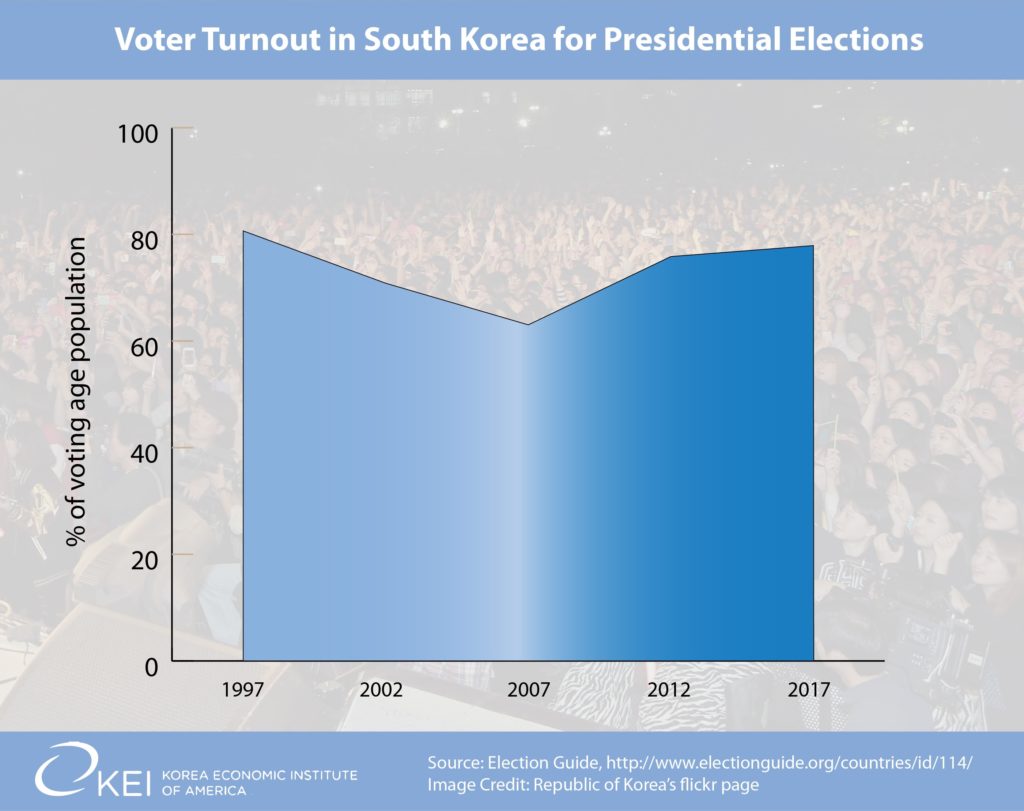The Peninsula
Why do Koreans Vote at a Higher Rate in Elections than Americans?
Published May 31, 2017
Category: South Korea

By Patrick Niceforo
According to the International Institute for Democracy and Electoral Assistance, South Korea’s 19th presidential election last May had a voter turnout of 77.9 percent, the highest it has been since 1997. This election was unique given that it took place following the impeachment of President Park Geun-hye. Accused of corruption, Park Geun-hye is the first South Korean president to be removed from office via impeachment and South Koreans’ frustration with their leadership was likely a major contributing factor to the increased voter turnout.
However, even prior to this presidential election, South Korea had a track record of high voter turnout relative to other countries. In fact, more than 60 percent of South Korea’s age-eligible citizens have voted in each of the last five presidential elections. On the other hand, voter turnout in the United States is consistently low across a similar period. It was lowest in 1996 at 49 percent and highest in 2000 at 58 percent. Only about 55 percent of the United States’ voting-age population participated in the 2016 presidential election.
Former Secretary General of South Korea’s National Election Commission, Joa Soon Im, cited youth outreach programs such as mock election days, celebrity endorsements, and ads in the media as strategies that have successfully increased voter participation. Another factor that could explain South Korea’s relatively high voter turnout is its voter registration process, or lack thereof. South Korean citizens, except those living abroad, who are 19 or older are eligible to vote without going through a formal registration process. In addition, election day is a holiday in Korea, meaning that most voters can go to the polls without worrying about taking the day off.
In contrast, the process for voter registration is complex in the United States, given that the rules vary by state. Same-day registration is only available in 10 states, and many other states lack an online registration mechanism. (A more comprehensive list of voter registration rules can be found here.) Others have cited reasons related to gerrymandering and apathy as negatively affecting voter turnout. Political apathy can come from several sources such as frustration with the status quo, complexity of issues, and the perceived irrelevance of some issues to individual voters.
Of course, there are other factors that may help explain low voter turnout. Particularly in the United States, demographic differences are prominent. Age and level of education seem to be reliable predictors of voting behavior, given that young people and those with limited education consistently have the smallest shares of the electorate. Given that South Koreans between the ages of 19 and 29 were also the smallest portion of the electorate, at first glance it may seem like South Korea similarly suffers from low voter turnout among its youth.
However, this may not necessarily be the case given South Korea’s top-heavy population. In other words, one reason that South Korean youth are the least represented may be because they are a relatively small portion of South Korea’s population. In the past two presidential elections, young South Koreans have outperformed young Americans at the voting booth. In the 2012 presidential election, over 65 percent of South Koreans between the ages of 19-29 voted, while in 2017 over 70 percent voted. Comparatively, less than 50 percent of Americans between the ages of 18-29 voted in presidential elections since 1984. Reasons such as unemployment, corruption, and outdated norms may have contributed to a greater share of South Korean youth participating in the 19th presidential election.
We cannot just measure voter turnout based on presidential elections, however. Similar to the United States, South Korea’s voter turnout is generally poorer when it comes to electing members to its national legislature. While there is room for improvement, South Korea’s consistently high voter turnout can provide lessons for the United States. Standardizing or eliminating voter registration as well as creating a holiday to allow people the flexibility to vote without hurting their paycheck could significantly boost turnout among American voters.
Patrick Niceforo is a graduate student at the Middlebury Institute of International Studies and an intern at KEI. The views expressed here are the authors’ alone.
Photo from Freshly Diced photostream on flickr Creative Commons.

